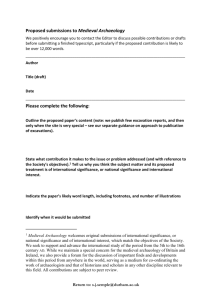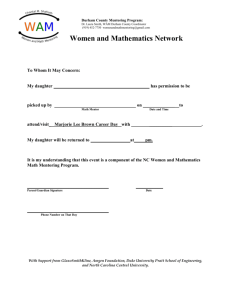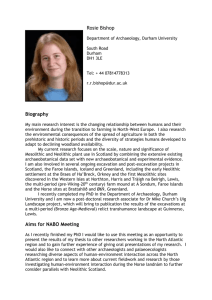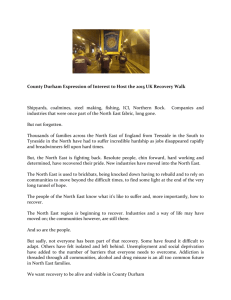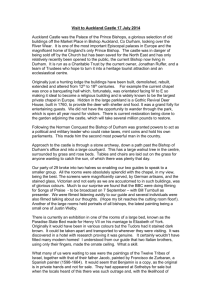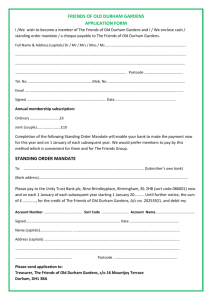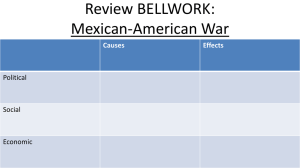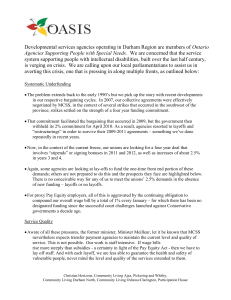ArchitecturAl And ArchAeologicAl Society of durhAm And
advertisement
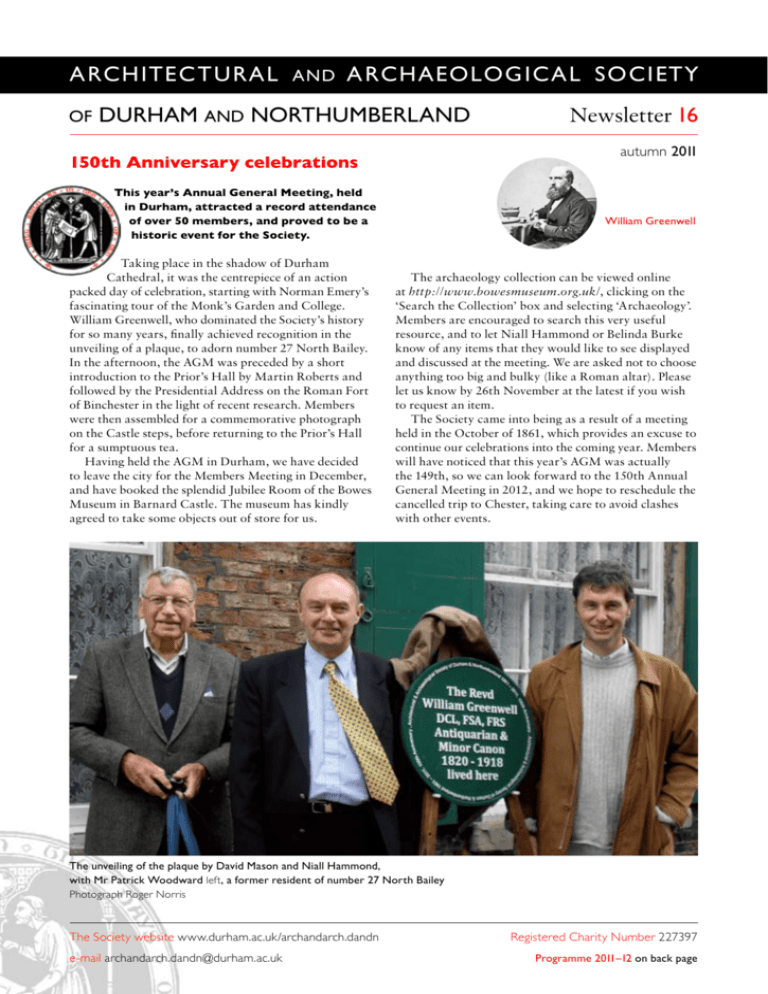
A rch itec t u ra l and A rchaeolog ica l Soci ety of Durham and Northumberland autumn 2011 150th Anniversary celebrations This year’s Annual General Meeting, held in Durham, attracted a record attendance of over 50 members, and proved to be a historic event for the Society. Taking place in the shadow of Durham Cathedral, it was the centrepiece of an action packed day of celebration, starting with Norman Emery’s fascinating tour of the Monk’s Garden and College. William Greenwell, who dominated the Society’s history for so many years, finally achieved recognition in the unveiling of a plaque, to adorn number 27 North Bailey. In the afternoon, the AGM was preceded by a short introduction to the Prior’s Hall by Martin Roberts and followed by the Presidential Address on the Roman Fort of Binchester in the light of recent research. Members were then assembled for a commemorative photograph on the Castle steps, before returning to the Prior’s Hall for a sumptuous tea. Having held the AGM in Durham, we have decided to leave the city for the Members Meeting in December, and have booked the splendid Jubilee Room of the Bowes Museum in Barnard Castle. The museum has kindly agreed to take some objects out of store for us. Newsletter 16 William Greenwell The archaeology collection can be viewed online at http://www.bowesmuseum.org.uk/, clicking on the ‘Search the Collection’ box and selecting ‘Archaeology’. Members are encouraged to search this very useful resource, and to let Niall Hammond or Belinda Burke know of any items that they would like to see displayed and discussed at the meeting. We are asked not to choose anything too big and bulky (like a Roman altar). Please let us know by 26th November at the latest if you wish to request an item. The Society came into being as a result of a meeting held in the October of 1861, which provides an excuse to continue our celebrations into the coming year. Members will have noticed that this year’s AGM was actually the 149th, so we can look forward to the 150th Annual General Meeting in 2012, and we hope to reschedule the cancelled trip to Chester, taking care to avoid clashes with other events. The unveiling of the plaque by David Mason and Niall Hammond, with Mr Patrick Woodward left , a former resident of number 27 North Bailey Photograph Roger Norris The Society website www.durham.ac.uk/archandarch.dandn e-mail archandarch.dandn@durham.ac.uk Registered Charity Number 227397 Programme 2011–12 on back page Professor Dame Rosemary Cramp Photograph Jeff Veitch Congratulations to Professor Rosemary Cramp on being made a Dame Commander of the Order of the British Empire (DBE) in the Queen’s Birthday Honours List. A member of our Society since she first came to the University of Durham, she served several times on the AASDN Committee before becoming our President from 2000 to 2003. Professor Cramp is currently involved with the bid by the joint Wearmouth– Jarrow monastic site to achieve World Heritage Site status, and continues to lead the team working on the Corpus of Anglo-Saxon Stone Sculpture, a project she initiated in 1977, with the publication of Volume 1 covering County Durham and Northumberland. She is currently bringing the report on her excavations at The Hirsel to completion. As Honorary Vice President, Professor Cramp continues to play an active role on our Committee, and takes a lively interest in all the Society’s activities. Uncovering the Barrowburn fulling mill The wheel pit at the downstream site The timber structure in the riverbed at the upstream site In the 13th century, the Newminster Abbey monks from Morpeth established themselves as large landowners in the Cheviots. Astute businessmen, the monks kept detailed records of their activities. One such record, dated between 1226 and 1244, mentions a fulling mill on the Coquet, near modern Barrowburn. Over a hundred years ago a local antiquarian, David Dippie Dixon, wrote that when the water was low, timber and masonry could be seen on the riverbed. Working from these clues, in 2010 members of Coquetdale Community Archaeology (CCA) found stonework and timber beams in the bank and the riverbed at two locations about 60 metres apart. Radiocarbon analysis confirmed that the timber was medieval, with dates compatible with the Newminster records. With grants from the Heritage Lottery Fund and English Heritage, CCA excavated the two sites in July 2010. At the downstream site, we uncovered a 4-metre long masonry wheel pit. A raised and chamfered entry point suggested a low breast-shot mill-wheel; curved abrasions in the pit showed it was about 3.4 metres in diameter. Just below the wheel pit, we found a lightweight timber structure with a planked floor; it might have been where cloth was rinsed after fulling. Above the entry point to the pit was a large timber baulk and a plank. These could be the remains of a flow control gate and a leat delivering water from upstream. At the upstream site, we uncovered a large timber structure on the riverbed. There have been several suggestions as to its purpose; weighing over a ton, it is most likely to have been the base for sluices that directed water into the leat. The scale of this mill provides a fascinating insight into the economy of the medieval Upper Coquet Valley. The monks’ investment, however, may not have been a wise one. Anglo-Scottish troubles laid waste to the area (a 1541 survey describes murderynge and takinge awaie) and the mill may have been abandoned in the 14th century. We plan to return in 2012 to try to find out more. For more information on this project, or CCA in general, please contact David Jones, e-mail domj49@ yahoo.co.uk. David Jones Excavations at Binchester 2011 The third season of excavation at Binchester saw a great advance in unravelling the later phases of the settlement’s history. More examples of the stone and clay-lined pits, and accompanying areas of paved platforms, were revealed, both in the east corner of the fort and in the portion of the civil settlement under investigation outside the south-east gate. One of those in the latter area was truly enormous, with an overall diameter in the region of 8 metres. Lengths of associated gullies were also found along with a pit cut into the top of the clay rampart that appears to have functioned as a well or water receptacle. Like the other pits investigated so far, their fills produced large amounts of animal bone, especially skulls and hooves. This activity is very reminiscent of that found during the excavations of the 1970s and 1980s within the commanding officer’s residence. Here, areas of hard-standing, pits and midden deposits associated with the slaughtering of animals, principally cattle, and the processing of their bones and hides, were found. Bone was being worked into everyday items such as knife handles and one would imagine that animal hides were being cleaned and cured to enable the manufacture of a range of leather goods. These features were dated to the 5th century and a couple of radiocarbon dates obtained this year suggest that similar activity in the newly excavated areas belongs to the same period. The fact that this sub-Roman / early medieval activity was taking place not just within the fort but also in the extramural settlement to the southeast is extremely interesting, because its widespread nature suggests that Binchester continued to exist as a thriving community of sorts well into the 5th century. As well as a market for the surrounding area, Binchester may have continued as a centre of military power. As communities were forced to become more self-reliant as the wider administrative and social structures disintegrated in this period, one can envisage a scenario in which the residue of the fort garrison continued to provide protection A portable altar, its inscription very eroded Photograph David Petts for the population in the surrounding area in return for supplies and materials. By the end of the season, further details of the structural development of the ‘barrack’ building inside the fort had begun to emerge. There are clearly two periods of masonry visible in the north outer wall, the rougher-hewn blocks of the later work contrasting with the neatly dressed facings of the earlier masonry. In some stretches a layer of soil intervenes between the two, suggesting a period of demolition followed by rebuilding. At some stage a wall had been built across the end of the alleyway separating this building from its neighbour to the north. Work on the intervallum road has begun to reveal the kerb and associated drain along its outer edge, while the circular structure cut into the rampart has been confirmed as the base of a (?bread) oven. Outside the fort, the layout of buildings to the east of Dere Street has become clearer. The latest surface of the road itself has been revealed throughout the excavated area along with a large drain. Most of the capping stones of the latter have cracked and collapsed, although a few are still in position. No buildings or structures have been found in the north end of the trench and this appears to be part of the ‘clear zone’ intervening between the builtup area and the defences. The building next to this was fairly modest in size, measuring approximately 4.5 by 13 metres. The entrance occupied the south half of the wall facing the road, with the remainder having a single large block of stone for its foundation. Immediately south of this and separated from it by a very small gap was another building of similar size but of much cruder, and obviously later, construction. In fact, the style of its masonry is very similar to that employed in the latest phase of the barrack building. Like the buildings found by Hooppell on the opposite side of the road in the 1870s, these buildings were equipped with a veranda along their Cut into the base of the rampart, this oven may have been used to bake bread Photograph Belinda Burke Newsletter 15 Corrections and further thoughts on Bishop Cosin’s Library A fragmentary inscription, SACE ... A EST ... QVTVM, referring to a shrine (sacellum) dedicated by the commander of the cavalry garrison (praefectus equitum) Photograph David Petts frontage supported by timber posts, each one set in a square recess cut in the top of a small stone block. Beyond this again lay an open space before the next building. This was clearly a very different type of building from the two ‘strip-buildings’ just described and extended beyond the confines of the trench both to the south and to the east. Although the uppermost deposits in its interior had been removed by two very large examples of the 5th-century pits, the excellent constructional quality of its walls and the nature of some of its appointments indicate a building of superior status. The front wall of the larger of the two rooms revealed incorporates two pairs of diagonal alignments of facing stones splayed towards the interior of the building. These appear to be window embrasures that were blocked up during a later stage in the building’s development, possibly at the same time as a porch-like structure was added to the front of the building. The interior of the latter has large patches of wall-plaster still in situ. A significant depression in the surface of the field a few metres to the east probably marks the spot where Hooppell uncovered a circular hypocausted chamber in the 1870s. There is a high probability that this was part of the regimental bath-building and the character of the rooms just described suggests that they too were part of this building. Bath-buildings at auxiliary forts tend to be of linear or reihentyp plan and the positioning of Binchester’s facility parallel with and a short distance back from Dere Street would explain why the ‘stripbuildings’ on this side of the road are much smaller than their counterparts opposite, as they had to fit in between the road and the baths. Notable finds this year include a small portable altar with a much eroded inscription, along with a fragment of a more impressive inscription. This was also religious in nature as it refers to a shrine (sacellum) and was apparently dedicated by the commander of the cavalry garrison (praefectus equitum). David Mason AASDN President In the previous newsletter, an article about Palace Green Library included a quote from William Greenwell, deploring the vandalism wrought by members of the University. It should have been made clear, however, that, while the speech was made at an urgently convened meeting that took place in Bishop Cosin’s Library, Greenwell was actually referring to the Castle, where the University was dividing the arcade of the Norman Gallery to make rooms for students. Thanks to the Society’s intervention, this process was halted before further destruction ensued. But, despite frequent meetings in Cosin’s library, there is no record of Greenwell ever having remarked on that building or its contents, whereas he spoke out on numerous occasions about other buildings, including the Cathedral. At this year’s AGM, Dr Doyle, a former Society President and Editor, recalled the centenary celebrations of the Society, and drew our attention to the restoration of Cosin’s library that took place in 1958, documented in the Centenary Issue of the Society’s Transactions (Vol XI, Parts III and IV, 1962) by the then librarian, David Goudie Ramage. Mr Ramage also wrote an account of the series of portrait heads painted by Jan Baptist Van Eerssell in Cosin’s library (Vol XI, Parts I and II, 1958), and subsequently himself painted further portraits of poets, lawyers and scientists for the small room adjacent to the main library. Mr Ramage was a member of the Society for many years, a vice president from 1967 to 1984 and editor of the 1958 volume of the Transactions. His obituary, written by Dr Doyle, appeared in Volume 3 of Durham Archaeological Journal. Dr Doyle has now employed further information regarding the arrangement of the portraits in Cosin’s library before the mid-19th century, to be published in the next volume of DAJ. Dr A I Doyle, former Editor of the Transactions and President of AASDN, addressed the AGM Photograph Gilbert MacKay Hornby Castle fieldwork Season 2 2011 Work at Hornby has continued apace over the summer with Trench 2, if anything, producing even more interesting results than Trench 1 last season. Digging in Trench 2 at Hornby Photograph Penny Middleton, Northern Archaeological Associates A dice made of whale bone from Flanders, 15th-century Photograph Patricia Smith A little below the level of a gravel path running from north-east to south-west across the trench, and datable from an embossed glass jar crushed in to the surface to the late 18th century, remains of a substantial stonebuilt structure have now been identified. It was initially thought to cover only part of the eastern half of the trench but, as the season has progressed, it has become clear that it covers the whole trench whilst extending out in each direction. Associated with it, a series of partially robbed-out internal walls have been identified along with several enigmatic timber structures which may be connected with furnishing. The removal of a dead tree adjacent to the north-east of the trench presented the opportunity to see how far it extended in that direction and a section of preserved timber-boarded floor was recovered. Subsequently, a further section of timberboarded floor has been located within the area of the trench. Advice on preservation of the flooring has been sought from York University Archaeology Department. The building has yielded a significant volume of small finds, suggesting a late medieval elite usage. Pottery dating from the late 12th century (as a residual deposit) through into the early 16th century has been recovered, with a concentration in the late 14th and 15th centuries during the heyday of the Conyers ownership of the Castle. The pottery seems to be of two principal forms, utilitarian cooking vessels, originating primarily with the Winksley kilns near Ripon, and more exotic table wares associated with the Humber ware kilns, with a number of imports from South West France and eastern Spain. There has been a particular preponderance of wine jug handles, suggesting some form of elite entertainment usage of the site which has been corroborated by the discovery of fragments of imported glassware and some high status meat bones from venison, wild boar, veal calf and rabbit, along with coarse and deep sea fish bones. Other finds suggesting an elite usage include a rowel spur of a design characteristic of the mid 15th century and a whale bone dice originating in Flanders, again of the mid 15th century. The building is constructed in local stone and bedded in substantial quantities of mortar in the manner of the adjacent medieval church building. We have had odd hints about internal furnishings, with evidence of a piped water system laid in elm timber pipes and indications of wood panelling with a very striking red plain tile roof for the building as a whole. The question arises as to what the building is and a range of suggestions have been made by experts in the field, such as Professor Jane Grenville of York University. The consensus of opinion has settled on a ‘pleasaunce’ or a place of entertainment for the Conyers family and their courtly associates, with a distinct visual relationship to the main Castle building. It is hoped to recover more of the building complex in future seasons and that in the long term the artefacts recovered will be displayed partly at the Castle site itself and partly at the Yorkshire Museum in York. If you would like any further information on the Hornby project, please contact the Society Fieldwork Officer, Erik Matthews, on telephone (01609) 773393, mobile 07951380829 or by e-mail at rubyna.matthews@btinternet.com. A fragment of Wedgewood porcelain c 1810 A 17th-century door handle Half size A clay pipe bowl from the 1820s Actual size Finds from Season 1 Photographs Carol Dougherty Excursions Sunday 7 May Mines, miners and Methodists in Weardale led by Ian Forbes Visit to the Primitive Methodist Chapel at Westgate, built in 1871. Having suffered from neglect since it fell out of use in 2007, it has now been acquired by the Historic Chapels Trust. After exploring the ruins of the mine, the party visited West Rigg Quarry at the top of Peat Hill. Here the quarrying of ironstone has exposed the mineral vein, mainly composed of quartz, but a thin strip of lead ore has been mined out of its centre. Saturday 2 July Richmond and Easby Abbey led by Erik Matthews and Niall Hammond The bouse teems at Low Slitt Lead Mine. This was where the ‘bouse’, or material brought out of the mine, was stored before processing. The miners worked in partnerships; and their wages, based on the amount of ore extracted, were divided between them. So the bouse mined by each partnership had to be stored and processed separately. A railway line ran over the top, emptying bouse from the mine into the teems. Saturday 6 August An Architectural Walk around Newcastle led by John Grundy Erik points out features in the undercroft of the principle chapel of Richmond Castle, with the 11th-century Scolland’s Hall in the background The 13th-century refectory of Easby Abbey, viewed from the south John Grundy on the steps of All Saints Church. The church was built in 1786– 96 by David Stephenson, replacing a medieval church within one of the four medieval churchyards in Newcastle. Society shop Research Report 1 (1985) The medieval cross slab grave cover in County Durham Peter Ryder Reduced price £1 members, £3 non-members An important reference work, reduced due to lack of storage space. Research Report 3 (1994) Excavated Bronze Age burial mounds of NorthEast Yorkshire M J B Smith £12 members, £15 non-members Previously thought to be sold out, a few copies of this much sought-after publication have recently come to light. Research Report 5 Past, present and future The archaeology of Northern England Catherine Brooks, Robin Daniels and Anthony Harding (eds) Reduced, £3 members, £5 non-members This very readable volume, consisting of papers presented at a conference in Durham in 1996, provides an overview of the archaeology of our area from early prehistory to the industrial period. The 150th Anniversary Book A Brief History of the Architectural and Archaeological Society of Durham and Northumberland on its 150th Anniversary 1861-2011 Janet McDougall £2.50. The perfect Christmas gift! Research Report 6 (2007) Acts of Perception A study of Barnard Castle in Teesdale 2 volumes David Austin Bargain price! £30 members, £45 non-members We also have some copies of the first print-run of Volume 1, some illustrations are slightly underinked (but this is barely noticeable), for the bargain price of £10. This volume covers the history of the castle and the excavation report; with Volume 2 devoted to the finds reports. Research Report 7 (2008) Roman Piercebridge Excavations by D W Harding and Peter Scott 1969–1981 H E M Cool and D J P Mason (eds) £20 members, £24 non-members This report has nearly sold out. The Keep of Richmond Castle with, to the east, a 19th-century building that served as a prison for conscientious objectors during the First World War Prints of the AGM group photograph featured in this book, taken by Michael Pilcher, may be purchased separately at £3.50 for A4 and £6.00 for A3 size. Please contact the secretary if you would like to purchase any of the above. The Society visited Richmond for its AGM in 1876, and were dismayed by a Georgian barrack block to the west of the tower, erected for the North York Militia (demolished in 1931) 150th Anniversary Programme 3 2011–2012 Saturday 15 October 2.00 pm 3.00 pm All lectures will be held at Elvet Riverside, Room 141 New Elvet, Durham, at 2.30 pm unless otherwise notified. Everyone is welcome to attend Egyptology double bill Protection of life and planning for death in ancient Egypt Dr Steven Snape Liverpool University Pest and pestilence The healing goddesses of ancient Egypt Dr Joyce Tyldesley Manchester University Joint event with the North East Ancient Egypt Society Saturday 29 October New light on ancient salt A lost prehistoric technology Professor Anthony Harding Exeter University, former Society Vice-president and Editor Saturday 26 November New light on the archaeology of County Durham Dr David Mason County Archaeology Officer and Society President Saturday 10 December Members Meeting at the Bowes Museum A chance to see objects from the archaeology collection held in store. For details, please contact the Society Secretary. Saturday 21 January Saturday 18 February Why do finds research? Lindsay Allason-Jones Newcastle University 800 years in the pleasure ground: Further thoughts on the archaeology of Hornby Castle, North Yorkshire Erik Matthews Society Fieldwork Officer Saturday 3 March Late medieval Cuthbertine pilgrimage to Lindisfarne and Farne A presentation of the evidence Emma Wells PhD student, Durham University Saturday 21 April Wednesday 2 May 6.30 pm May From sun and sand to coal Saltmaking and the ‘Long Industrial Revolution’ David Cranstone Cranstone Consultants Heirlooms and ancient objects Connecting the lives of medieval people and things Professor Roberta Gilchrist Reading University Annual General Meeting Date and venue to confirm Saturday 9 June The Gristhorpe Man Project Antiquarianism to archaeological science Dr Janet Montgomery Durham University Dr Nigel Melton Bradford University Further diary dates Monday 24 October 2011 Northumberland History Fair Woodhorn, QEII Country Park, Ashington 11.00 am to 4.00 pm Saturday 10 March 2012 Saturday 2 June 2012 Durham County Archaeology Day Sunderland History Fair Officers 2011–12 President Dr David Mason County Archaeology Officer, Culture and Leisure, Durham County Council, Rivergreen Centre, Aykley Heads, Durham DH1 5TS telephone (0191) 370 8842 e-mail david.mason@durham.gov.uk Vice President Mr Niall Hammond Marion Cottage, Lartington, Barnard Castle, County Durham DL12 9BP telephone (01748) 875 058 e-mail niall.hammond@aenvironment.co.uk Vice President Dr Andrew Millard 1 The Terrace, Meadowfield, Durham DH7 8RU e-mail a.r.millard@durham.ac.uk Editorial team contact Dr David Petts Department of Archaeology, Dawson Building, South Road, Durham DH1 3LE telephone (0191) 334 1166 e-mail d.a.petts@durham.ac.uk Honorary Secretary Mrs Belinda Burke Broom Cottage, 29 Foundry Fields, Crook, County Durham DL15 9JY telephone (01388) 762 620 e-mail BelindaLBurke@aol.com Honorary Treasurer Mr Simon Alderson 27 Findon Hill, Sacriston, County Durham DH7 6LS telephone (0191) 371 0427 e-mail simon@simonalderson.co.uk Honorary Membership Secretary Mrs Maureen Smith 6 Girton Close, Peterlee, County Durham SR8 2NF telephone (0191) 586 6259 Publicity Officer Ms Christina Unwin 30 Southside, Shadforth, County Durham DH6 1LL telephone (0191) 372 3939 e-mail christina@wave.demon.co.uk Design Christina Unwin e-mail christina@wave.demon.co.uk Printing Alphagraphics, Durham telephone (0191) 384 9777 www.agnortheast.com

